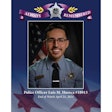Responding to calls involving violent, incoherent or uncontrollable subjects is never easy. Unlike rational individuals who can be taken into custody with little more than a show of authority, irrational subjects are extremely unpredictable. They may act out violently without regard for personal officer safety. Extreme measures and considerable force are often necessary to subdue such individuals. When responding to this type of call, be aware that your life, as well as your subject's, may be on the line.
Unfortunately, some common methods of restraint can inhibit oxygen flow and cause trauma to the body's organs. It is this oxygen deficit that may cause injury or kill a subject, bringing the involved agency under fire.
Pepper spray and other similar chemical compounds used to control combative subjects. The spray may subdue a subject, but it also constricts the windpipe, reducing the amount of oxygen that can pass into the lungs. The strain of the struggle itself causes a greater need for oxygen in the blood. Alcohol, methamphetamines or other harmful substances can elevate blood pressure and increase the body's need for oxygen.
The methods used to restrain combative subjects often put them in a position that interferes with breathing and reduces the amount of oxygen to the lungs. A subject may be wrestled to the ground in a facedown position with his hands cuffed behind him and officers kneeling on his back and legs. If further control is necessary, additional officers often pile on top of the subject. This type of restraint makes breathing very difficult and contributes to further resistance as the body automatically struggles to take in more oxygen.
The subject must stop struggling for his lungs to fully expand and take in more oxygen. When he or she is finally subdued, it is critical to increase the oxygen recovery rate. If the level of oxygen in the blood does not increase, asphyxia may result.
Positional asphyxia, which can result in death, is a medically accepted syndrome. A variety of occurrences such as crib death and in-custody deaths of suspects who have been subdued by police have been attributed to positional asphyxia.
A March 1994 article in the International Chiefs of Police bulletin concluded that the sudden death of a person in police custody is neither a new phenomenon nor the result of the use of pepper spray. Such a death is the result of various factors, including the individual's physical condition and the method used to subdue and restrain him.
A 1995 article in a National Law Enforcement Technology Center bulletin reviewed this syndrome and advised officers to avoid using prone restraint techniques in an effort to decrease the risk of positional asphyxia.
As expected, the deaths resulting from police restraint techniques have spawned a rash of lawsuits against law enforcement agencies. A $10 million brutality suit was recently filed against the San Francisco Police Department by family members of Aaron Williams, who died while in police custody. The medical examiner attributed his death to excited delirium.
The Legal Battle
High-dollar claims against police departments are not uncommon in these situations. Dr. John Clark, chief medical officer for the Los Angeles Sheriff's Department, said that deputies should stop using restraint methods developed at a time when police encountered mostly young, healthy men in violent states. He added the sheriff's deputies were told a "couple years ago" to stop hog-tying people.
"There are a few times when you have to take people down, but do it swiftly and then lay them on their sides, not face down," advised Clark.
In response to another death in the San Francisco Bay area in March 1996, john Crew, a spokesman for the northern California chapter of the American Civil liberties Union, said that they have investigated 15,000 pepper spray incident reports and found that it was being used in California about once an hour. Sprayed suspects were dying, he added, about once a month.
The proliferation of lawsuits resulting from these deaths has caused many police agencies to consider discontinuing pepper spray use. This misses the point, however, since many studies show that pepper spray is not the problem; death results when oxygen levels in the blood fail to recover quickly.
Taking the Wrap
To overcome the problems associated with subduing violent subjects, Sgt. Ron O'Dell and Sgt. Craig Zamolo of the Walnut Creek (Calif.) Police Department developed a new restraint device called The Safe Wrap (The Wrap). This device allows police officers to restrain and immobilize violent suspects without the dangers associated with traditional restraint methods.
O'Dell calls The Wrap a straightjacket for the legs. It immobilizes the lower torso while allowing the suspects to stay in a seated position. The Wrap restricts his ability to kick or do harm to himself or others, and since the largest muscle group in the human body is in the lower torso, this form of immobilization is crucial for effectively restraining an individual.
About two years ago, while O'Dell and Zamolo taught defense, arrest and restraint techniques at the County Criminal justice Training Center, Chief Karel Swanson asked them to look into the problems of restraining violent suspects with traditional techniques. Swanson was concerned about in-custody deaths and public accusations that pepper spray and hog-tying were to blame.
As a result of researching the issue, the two officers felt it was necessary to find a better restraint method. After spending about a year testing prototypes in training classes throughout California and utilizing input obtained from medical experts, The Wrap was developed.
O'Dell explained that it may take as many as four officers on top of a violent suspect to get him handcuffed and hog-tied, creating a tremendous amount of pressure on the subject's chest and lungs. And a suspect can still fight and kick even with four officers restraining him because hog-tying allows a lot of movement in the thighs and hips.
According to O'Dell, The Wrap makes it impossible for a suspect to move his legs. But while there is loss of leg movement, there is no loss of circulation or feeling in the legs. The Wrap provides a secure restraint while the individual is in an upright position and able to breath freely.
On the street, it takes approximately three officers to "wrap up" a combative suspect-two to hold him down and the third to wrap him up. The suspect's hands can either remain in the handcuffs, secured to the back of The Wrap, or they can be strapped to The Wrap at the suspect's waist.
Additional Benefits
Paramedics are prohibited by California law from transporting people in handcuffs, but when police release handcuffs to turn a suspect over to paramedics, the struggle will often start all over again. O'Dell related an incident he witnessed where a paramedic had part of her thigh bitten off while the suspect was being strapped to a gurney.
A significant benefit of The Wrap is that it may be left on a suspect while he is being taken to a hospital. Doctors have even requested that patients be restrained by The Wrap while being treated. This reduces the risk of injury to medical personnel by patients who remain combative after being brought into the hospital.
There has been speculation by medical consultants that wrapping a person in a cocoon-like device may produce a psychologically calming effect. During the year of field testing at the Walnut Creek Police Department, officers have observed this calming effect.
The most significant result of medical testing was the discovery that subjects restrained by The Wrap have blood oxygen recovery rates similar to those who are unrestrained. When blood oxygen levels recover, the chance of injury or death is greatly reduced.
The Wrap was put on the market in April 1996 after the year of testing and research. If has received positive responses from law enforcement agencies, the medical community and airport and hotel security.
The Wrap provides a workable alternative to hog-tying and is a positive step toward solving the problem of in-custody death syndrome and the danger of liability associated with taking custody of combative subjects.
David E. Brule is an attorney in Walnut Creek, Calif., and a retired federal criminal prosecutor who has served more than 20 years in law enforcement.
For more information on The Safe Wrap, contact
Safe Restraints Inc.
1500 Newell Ave. Suite 408
Walnut Creek, CA 94596
(800) WRAP-911
This article is for supplemental purposes only. The author, POLICE and/or Safe Restraints Inc., accept no liability whatsoever for injuries to persons or property resulting from the information presented or implied in this article.










